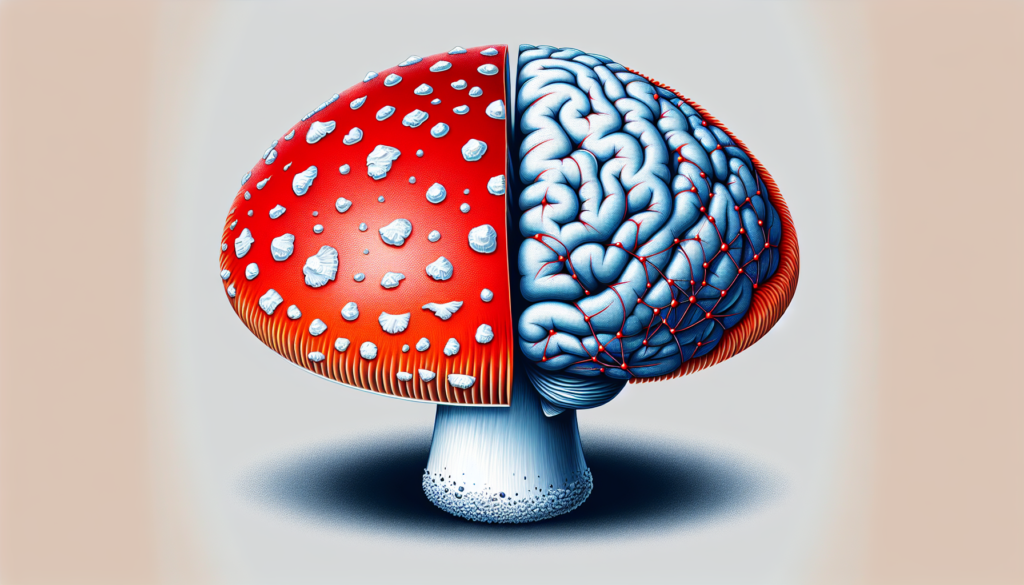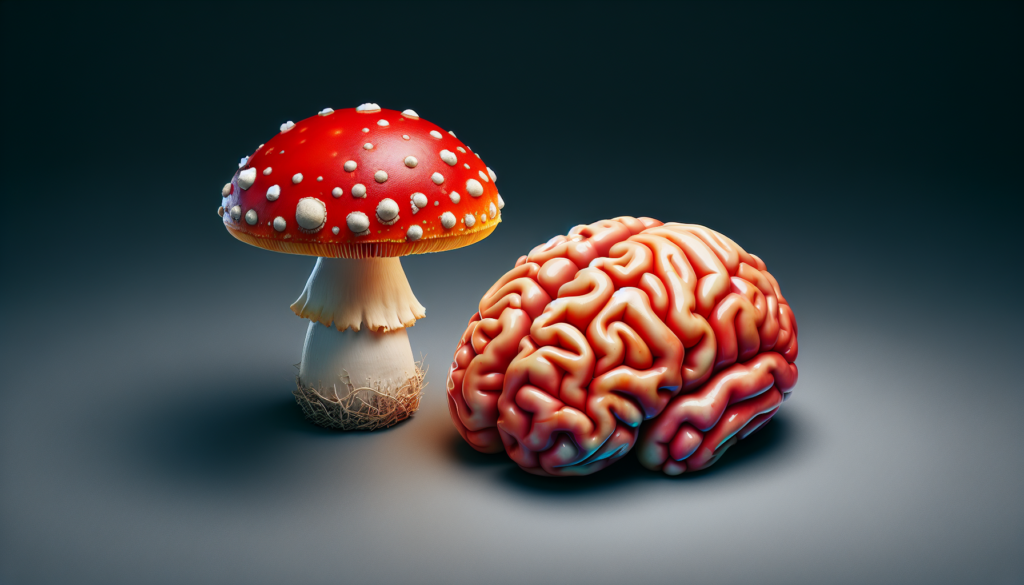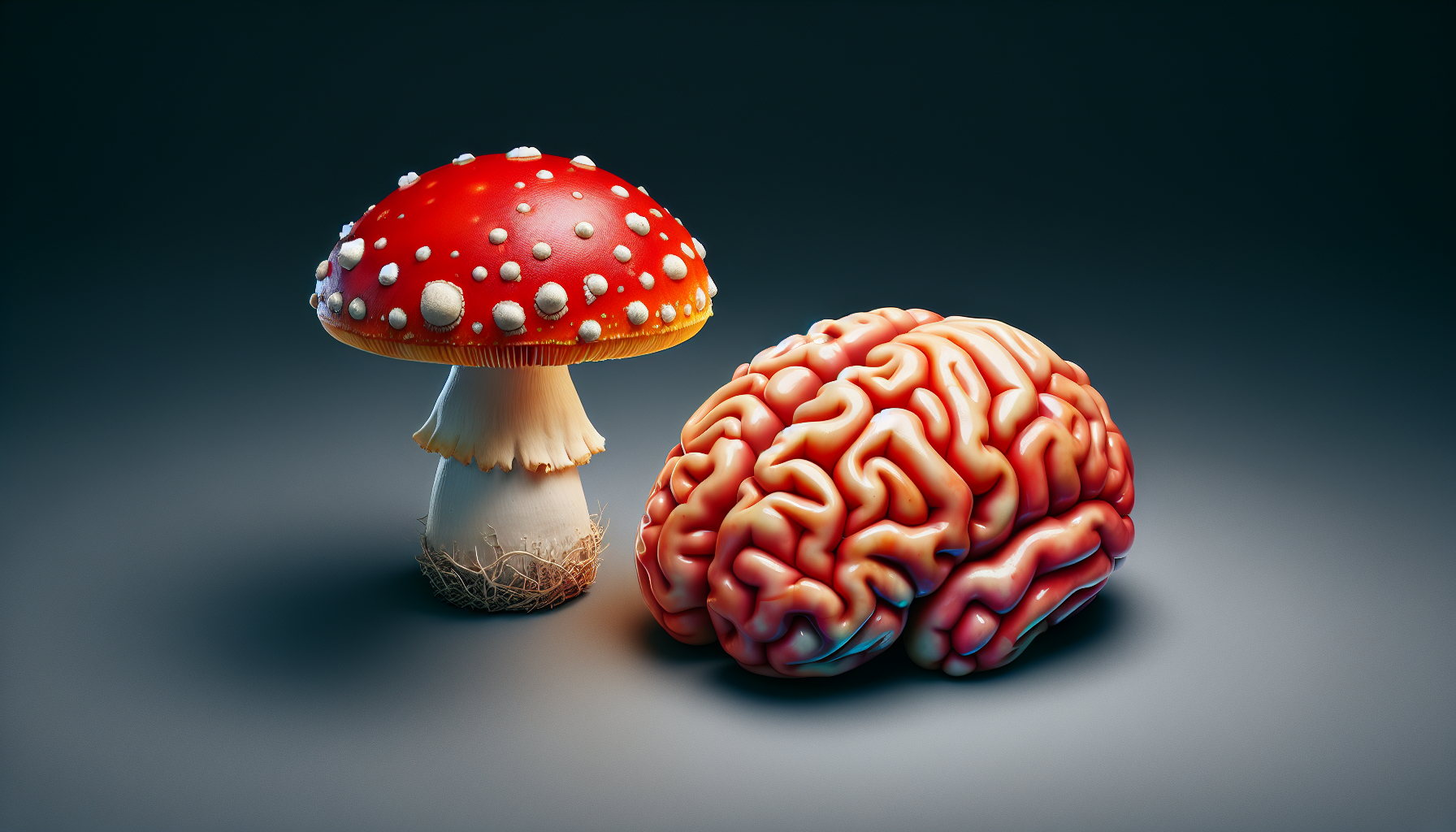Imagine stumbling upon a peculiar mushroom in the depths of a dense forest. Its red cap dotted with white spots, almost resembling a fairytale illustration. As you pick it up, curiosity floods your mind. What secrets does this extraordinary organism hold? Specifically, what does Amanita muscaria, commonly known as the fly agaric, do to the human brain? In this article, we embark on a journey to unravel the enchanting effects this infamous mushroom has on our minds. Brace yourself for a captivating exploration into the mysterious realm of Amanita muscaria.

Overview
What is Amanita Muscaria?
Amanita muscaria, also known as the fly agaric, is a species of mushroom that has a long history of use in various cultures around the world. It is known for its distinctive appearance, with a bright red cap covered in white spots. While it may be visually appealing, Amanita muscaria is also known for its psychoactive properties, making it a subject of fascination and intrigue.
Historical and Cultural Significance
Amanita muscaria holds a significant place in the history and cultures of many societies. It has been used for religious and spiritual purposes by indigenous peoples in Siberia, North America, and Europe. It has deep roots in shamanic practices, where it was believed to provide access to altered states of consciousness and divine realms. In some cultures, it symbolizes fertility, healing, and even serves as a gateway to the spirit world.
Chemical Composition
Ibotenic Acid
Amanita muscaria contains several compounds that contribute to its psychoactive effects. Ibotenic acid is one such compound found in the mushroom. It is considered a prodrug, meaning that it is metabolized in the body into another substance, muscimol, which is responsible for the majority of the mushroom’s psychoactivity.
Muscimol
Muscimol is the primary psychoactive compound found in Amanita muscaria. It acts as a GABA-A receptor agonist, meaning that it binds to the GABA receptors in the brain and enhances their inhibitory effects. This results in a reduction in neuronal activity, leading to sedative and calming effects.
Other Compounds
In addition to ibotenic acid and muscimol, Amanita muscaria also contains other compounds such as muscimol acid and muscazone. These compounds are less well-studied but may contribute to the overall effects of the mushroom.
Pharmacological Effects and Mechanisms of Action
GABAergic Activity
The GABAergic activity of muscimol plays a crucial role in the psychoactive effects of Amanita muscaria. By enhancing the inhibitory effects of GABA, muscimol can induce sedation, relaxation, and a sense of calmness. This may explain the mushroom’s traditional use in spiritual and meditative practices, as it promotes a state of tranquility and introspection.
Effects on Glutamate
While muscimol primarily acts on GABA receptors, Amanita muscaria also has an effect on the glutamate system. Glutamate is the primary excitatory neurotransmitter in the brain, and its balance with GABA is essential for maintaining normal brain function. Amanita muscaria’s interaction with the glutamate system may contribute to its cognitive and perceptual effects.
Other Receptor Interactions
In addition to GABA and glutamate receptors, Amanita muscaria may interact with other receptors in the brain. It has been suggested that the mushroom may have affinity for certain serotonin receptors, which could contribute to its hallucinogenic effects. Further research is needed to fully understand these interactions.
Neurotransmitter Modulation
Dopamine
Amanita muscaria has been found to modulate dopamine levels in the brain. Dopamine is a neurotransmitter associated with reward, pleasure, and motivation. The mushroom’s effects on dopamine may contribute to the sense of euphoria and connectedness reported by some users.
Serotonin
Serotonin is another neurotransmitter affected by Amanita muscaria. Serotonin is involved in regulating mood, appetite, and sleep. The mushroom’s interaction with serotonin receptors may explain its potential antidepressant and anxiolytic effects. However, more research is needed to fully understand these mechanisms.
Other Neurotransmitters
Amanita muscaria may also interact with other neurotransmitters, such as norepinephrine and acetylcholine. These interactions may contribute to the mushroom’s diverse range of effects on cognition, mood, and perception. Further investigation is necessary to uncover the full extent of its effects on neurotransmitter systems.

Effects on Cognition and Perception
Hallucinations
One of the most well-known effects of Amanita muscaria is its ability to induce hallucinations. These hallucinations can vary from mild distortions of perception to more vivid and immersive experiences. The exact mechanisms behind these hallucinations are still not fully understood but may involve interactions with serotonin receptors and modulation of glutamate activity.
Heightened Sensory Perception
In addition to hallucinations, Amanita muscaria can enhance sensory perception. Colors may appear more vibrant, sounds more distinct, and tactile sensations more intense. This heightened sensory perception may contribute to the mushroom’s traditional use in spiritual and ceremonial practices, where it is believed to facilitate a deeper connection with the natural world.
Changes in Consciousness
Amanita muscaria can also lead to alterations in consciousness. Users often report a shift in their sense of self, a feeling of being connected to a larger whole, or a dissolution of boundaries between themselves and their environment. These changes in consciousness can foster introspection, facilitate spiritual experiences, and potentially offer new perspectives on life.
Psychological and Emotional Effects
Euphoria
Amanita muscaria has the potential to induce a sense of euphoria in some individuals. This feeling of intense happiness and well-being may be attributed to the mushroom’s effects on dopamine and serotonin systems. However, it should be noted that the intensity of euphoria experienced may vary between individuals and is not guaranteed in every case.
Sense of Connectedness
Many users of Amanita muscaria report feeling a strong sense of connectedness to nature, other people, or the universe. This feeling of interconnectedness may arise from the mushroom’s ability to alter neural pathways and perception. It can provide a profound sense of unity and harmony, leading to a deeper appreciation for the interdependent nature of existence.
Anxiety and Fear
While Amanita muscaria is generally associated with positive emotional effects, some individuals may experience anxiety or fear during their psychedelic experience. This can be influenced by various factors, including personal disposition, set, and setting. It is important to approach the mushroom with respect and caution, as adverse emotional effects can occur in sensitive individuals.
Neuroprotective Properties
Antioxidant Activity
Amanita muscaria has been found to exhibit antioxidant activity, meaning it can protect brain cells from oxidative stress and damage. Oxidative stress is implicated in the development of neurodegenerative diseases, such as Alzheimer’s and Parkinson’s. The mushroom’s antioxidant properties may offer potential neuroprotective benefits, although further research is needed to explore this possibility fully.
Potential for Neuroregeneration
Some studies suggest that Amanita muscaria may have the potential to promote neuroregeneration, the process of regrowing and repairing damaged neurons. This could have significant implications for the treatment of neurodegenerative disorders and brain injuries. However, more research is required to understand the mechanisms through which the mushroom may facilitate neuroregeneration.
Toxicity and Adverse Effects
Gastrointestinal Disturbances
Consuming Amanita muscaria can lead to gastrointestinal disturbances, such as nausea, vomiting, and diarrhea. These effects are often mild and transient but can still be unpleasant. It is important to be mindful of the mushroom’s potential impact on the digestive system and to take it in a controlled and informed manner.
Muscle Weakness and Coordination Issues
Amanita muscaria contains certain compounds that can cause muscle weakness and coordination issues. This can result in difficulties with motor control, balance, and coordination. It is essential to exercise caution if engaging in activities that require physical coordination while under the influence of the mushroom.
Liver Toxicity
Amanita muscaria has been associated with liver toxicity, especially when consumed in large quantities or in combination with other substances. The mushroom contains toxins that can damage the liver and lead to serious health complications. Proper dosage, careful preparation, and informed use are crucial to minimize the risk of liver toxicity.
Therapeutic Potential
Treatment of Alcohol and Substance Dependence
Some preliminary studies suggest that Amanita muscaria may have therapeutic potential in the treatment of alcohol and substance dependence. The mushroom’s effects on neurotransmitters involved in reward and addiction pathways may help reduce cravings and withdrawal symptoms. However, further research, including clinical trials, is necessary to validate these findings and establish safe and effective protocols.
Potential for Mental Health Disorders
Amanita muscaria’s psychoactive properties have led to speculation about its potential in the treatment of mental health disorders such as depression, anxiety, and post-traumatic stress disorder (PTSD). However, the current evidence is limited, and more research is needed to determine its efficacy, safety, and appropriate dosage for therapeutic use.
Research and Future Directions
Current Studies on Amanita Muscaria
Research on Amanita muscaria is limited compared to other psychedelic substances. However, there is a growing interest in understanding the mushroom’s pharmacological properties, mechanisms of action, and potential therapeutic applications. Current studies are focusing on elucidating its effects on neurotransmitter systems, exploring its neuroprotective properties, and investigating its potential as a therapeutic tool.
Exploration of Novel Therapeutic Applications
As interest in psychedelic research continues to grow, there is an increasing recognition of the need to explore the therapeutic potential of Amanita muscaria, alongside other psychedelics. Future research may delve deeper into its applications for mental health disorders, addiction, neurodegenerative diseases, and other areas of medicine. The mushroom’s unique chemical composition and cultural significance make it a promising subject for further investigation and exploration.



